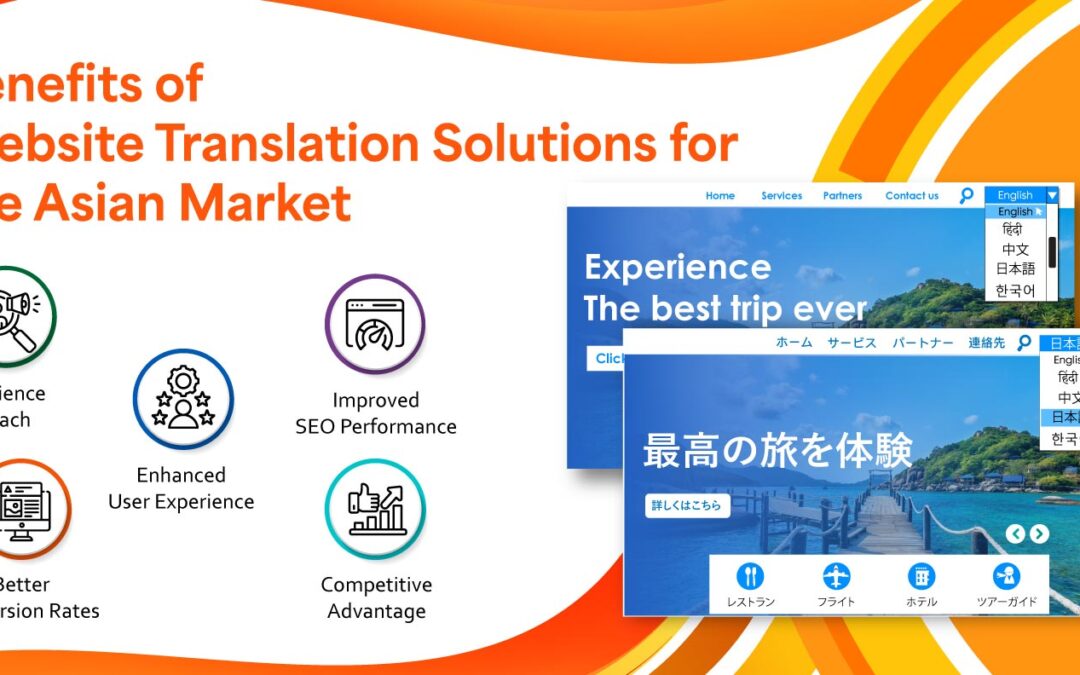Asia is the largest continent, covering many culturally diverse and geographically and economically important regions, including the Far East, South East, Central Asia, Indian Subcontinent, Russia (Asian part), and the Middle East. The continent hosts nearly 50 countries, all of which are culturally and linguistically diverse. Even when it comes to the economy, Asia proves itself a significant contributor in terms of market opportunities as well as revenue. No wonder every global corporation looks to establish a solid presence across Asian countries!
However, penetrating these diverse marketplaces isn’t as straightforward. Translations and localization, particularly digital ones, play a crucial role. If you are a business eyeing the Asian market, one of the first things you need is a website that speaks your target language region.
This is where a website translation solution comes into the picture. Let’s explore some aspects associated with it in this blog that talks about breaking into the Asian market by leveraging language as a medium.
Asian Market Size – Overview
The Asian economy is a thriving one. Major contributors include India, China, Singapore, Japan, South Korea, Indonesia, etc. These countries excel in different areas. For example, India is a multi-faceted economy that contributes through sectors, including manufacturing, automobiles, IT, textile, defense, pharmaceuticals, entertainment and many more.
On the other hand, China, which is another massive player, relies upon manufacturing, financial services, real estate, mining, agriculture, etc.
The ongoing growth and enormous promise these sectors show make Asia an economy everyone wants to leverage!
As a result, even when it comes to numbers, Asia is a player to reckon with. The continent contributed to more than half of the global GDP growth between the mid last decade to early this decade. As for global trade, Asia’s role in the world’s largest trade routes accounted for more than half of the global trade value.
Of course, the continent’s size and number of countries play a critical role in Asia’s enormous contributions. However, what also matters is the number and type of industries the continent is home to. Besides, the culturally diverse environment fosters an innovative environment making the world a richer and better place.
As an organization looking to leverage the potential of the gigantic and diverse Asian market, you must have different strategies on hand. One of them is localization, including website translation. It can benefit you in various ways, laying the foundation for a solid presence in the Asian market. Here’s more to it.
5 Benefits of Website Translation Solutions for the Asian Market!
Here’s how a website translation solution for Asia proves advantageous.
1. Increased Audience Reach
Offering your website in multiple Asian languages like Hindi, Marathi, Punjabi, Thai, Malay, Chinese, Arabic, Kurdish, Urdu, etc., helps you tap into the respective non-English speaking markets, helping you broaden your audience or customer base. Furthermore, a country like India, which has many other internal languages, including the major ones, can help you amplify your business impact and target even more regions and audience groups.
2. Enhanced User Experience
As humans, we feel comfortable interacting with people who can speak and understand our language. Business websites aren’t an exception to it. Visitors potentially engage with content they can easily understand, resulting in a better user experience. They trust such brands and businesses more and would transact with them more frequently. A multilingual website also reflects a company’s respect for diverse cultures and attempts to interact with prospects in their language.
3. Improved SEO Performance
Nowadays, marketing is incomplete without SEO. Including local Asian languages in the website and targeting keywords and key phrases in the respective language can help you enhance your SEO performance and rankings across specific regions. It can help you drive more organic traffic and make your website a platform producing potential opportunities.
4. Better Conversion Rates
Content in a user’s local language leads to better understanding, helping make interactions and engagement more meaningful. Such users would take the desired actions like downloading a whitepaper, watching a video, filling in the contact form, or buying something. Website translation refers to a more personalized marketing strategy that can help enhance conversion rates.
5. Earn a Competitive Advantage
Establishing your presence and succeeding amidst the highly competitive environment of Asia is no joke. You need several factors to differentiate you from the local or global players within the market. One of them is a multilingual website. Remember, even today, many businesses operate in a single language. Thus, your multilingual website can become a standout, helping you garner more visibility, attention, traffic, and prospects.
Linguify – Your Website Translation Solution for Asia
Linguify from LinguaSol is a premium website translation solution for over 200 languages worldwide, including many from Asia. It is the result of years of LinguaSol’s extensive understanding of translation and business requirements related to it. The solution packs a range of features, including SEO-friendly translation, prompt and accurate change management, UI localization, content capturing and selection, data security and NoCode translation. Please email us at sales@linguasol.net to connect with our experts and explore Linguify better.
Ref. No- LSB10241050

